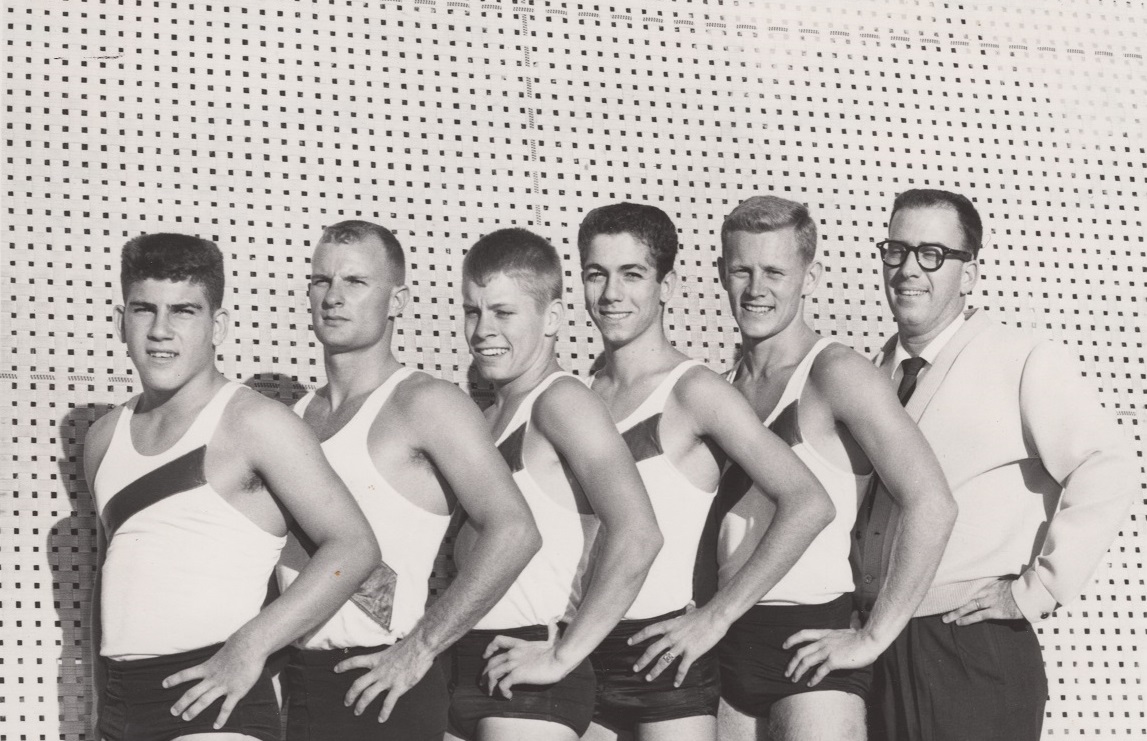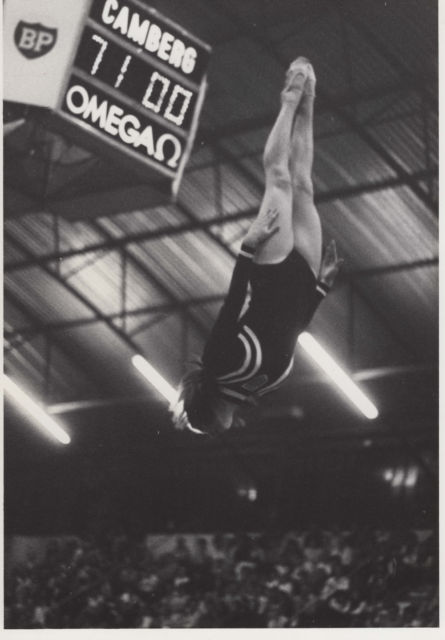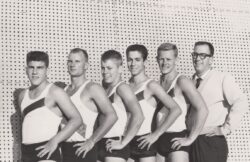Jumping Jehoshaphat!
The legacy of UL Lafayette trampolining coach Jeff Hennessy
Published: August 31, 2021
Last Updated: March 22, 2023

Leigh Hennessy Robson
Hennessy and his team in front of a trampoline in 1962. From left to right: Wayne Miller, Charles Stewart, Frank Schmitz, Jim Bussolati, Bill Meagher, Hennessy.
Though his name appeared across the sports sections of various newspapers like the Times–Picayune and the Shreveport Times, Jeff Hennessy’s journey to securing trampolining a spot on national and international levels was anything but a guarantee. He pioneered a new sport and continually dominated competitions; however, Hennessy had no shortage of naysayers along the way. Dedication allowed Hennessy and his teams to persevere, as demonstrated by a line from a September 1972 Vermillion article stating that Hennessy’s athletes were preparing to compete in “some far corner of the globe that regularly nets for Southwestern a world champion, or two or three.”
“I went to USL in the late 1970s. At that time he was like a rock star on the campus,” said former UL Lafayette soccer coach Mark Robson. Hennessy arrived in Lafayette and started teaching at the university in 1959. Having competed as a student gymnast at Northwestern State University in Natchitoches and coached at West Monroe High, Hennessy became USL’s gymnastics coach. He convinced the university to purchase a Nissen trampoline to help the diving, swimming, and gymnastics teams with conditioning; he then took on the joint role as the trampoline coach. Many of Hennessy’s athletes competed outside of the university as part of the Southwestern Gymnastics Club with him at the helm. Hennessy recognized talent outside of the university, which allowed him to scout younger gymnasts. In 1961, the Southwestern Gymnastics Club traveled to the Southern Amateur Athletic Union (AAU) Championship in New Orleans. In addition to the club’s regular members, Hennessy added a high school freshman and sophomore, as well as one non-student to the roster.
Jeff Hennessy’s successes with the trampoline were not all linear ascents. Opposition to the sport came in the form of safety concerns. The American Academy of Pediatrics attempted to ban the trampoline because of children’s injuries surrounding the device, and some universities fell in line with their recommendation. Sarasota Herald-Tribune sportswriter Mark Cardon interviewed Jim Culhane, a member of the 1972 US Olympic team in an interview titled “Olympic Gymnast Culhane Says, ‘We Are Pushing Kids Too Fast.’” Culhane thought kids were being pushed beyond their competitive capabilities. Because of a rise in the number of trampoline-related incidents, parents grew concerned and began to oppose the sport.
Jeff Hennessy’s nurturing side as a coach and determination to implement safety measures is what ultimately turned the tide of skepticism away from the trampoline. Dean Kenneth Clarke from the University of Illinois at Urbana-Champaign reversed his pushback on the trampoline’s use because of “Hennessy’s attempts to not only understand the dangers, but also his conviction in fixing the problems.”

Jordan Richardson Leigh Hennessy, daughter and student of Jeff Hennessy, catches some air at the world championships in South Africa in 1974. Leigh Hennessy Robson
Hennessy’s The Trampoline As I See It was published in 1967. In the book, Hennessy outlined many of the rules and techniques for safely competing and using the device. In 1978, Hennessy helped develop the American Alliance for Health, Physical Education, Recreation and Dance policy on the uses of the trampoline. Jeff Hennessy coached athletes of all ages, but he also invested in them as people by closely monitoring their health and fitness. He positively addressed his athlete’s shortcomings and expressed to the public when he believed his teams would not be able to compete at their best. His personal papers contain handwritten notes detailing improvements and technique changes for his athletes’ routines. Hennessy went on record to explain injuries and recoveries, including his daughter Leigh Hennessy’s rebound from surgery to remove a tumor from her leg when she was only eleven. (Leigh went on to be among the top six girls in the nation at age twelve and later became a two-time World Champion.)
Jeff Hennessy’s colleagues thought highly of him as both a man and a coach. After nearly thirty years of coaching, Hennessy became a candidate for the National Sports Hall of Fame Award. In a flood of recommendation letters in the early months of 1981, his colleagues provided positive statements describing Hennessy as “very dedicated, knowledgeable, and capable.” They realized that his passion for the trampoline promoted competitiveness while improving health and neuromuscular skills.
In a 1972 Vermillion interview, Coach Hennessy told an interviewer, “We have some of the finest trampolinists in the world right here at the University of Southwestern Louisiana.” The many success stories his athletes brought to the university validated his statement. His honors included becoming the National Trampoline Chairman, USA Representative to the International Trampoline Federation, the United States Olympic trampoline team coach from 1964 to 1980 (leading the team in nine World Championships), leading the National AAU Champions from 1964 to 1975 and 1979 to 1981, and induction into the USA Gymnastics Hall of Fame in 1992. Jeff Hennessy died at age eighty-five in March 2015, but his reign as one of UL Lafayette’s most decorated coaches remains part of the university’s legacy.
Public historian and archival assistant Jordan Richardson works at the University of Louisiana–Lafayette in the Ernest J. Gaines Center. His areas of study are southern antebellum history through Reconstruction. A 2018 UL Lafayette and 2014 LSU graduate, Richardson is from Amelia, Louisiana.
